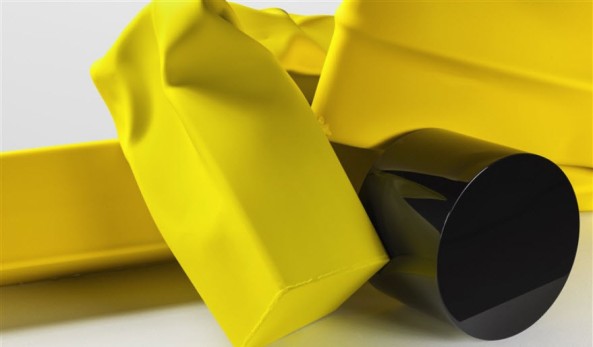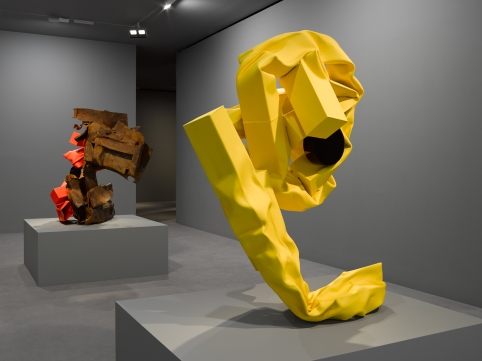Carol Bove at David Zwirner
June 8 to August 3, 2018 at 24, Grafton Street, London

May, 2018 (detail) Stainless steel and urethane paint
21 x 66 x 28 inches (53.3 x 167.6 x 71.1 cm)
© Carol Bove
Courtesy the artist and David Zwirner New York/London/Hong Kong
The Covid-19 pandemic has closed galleries for many weeks, and a plethora of online initiatives for displaying art, both contemporary and historical, have been taking place. From virtual tours of our major galleries to shows specifically curated for the digital platform there has been much to see, albeit in understandably compromised and impaired form. I must admit straightaway that the increased online content has not particularly engrossed me, probably because I have not tried hard enough, but in my defence, I just prefer to see the ‘real thing’. These would be not only the exhibitions I may have seen last week or even yesterday, where the experience would be fresh in my mind, or the shows I anticipate for tomorrow or next month, but also the shows from some time ago. This wishful thinking is due to focussed reminiscence, rather than some quirk of the lock-down effect on the deeper layers of consciousness, but is a welcome indulgence.
So, as I contemplate exhibitions I am now missing – most especially ‘Titian: Love, Desire, Death’ at the National Gallery in London and ‘Young Rembrandt’ at the Ashmolean Museum in Oxford – I also recollect exhibitions that I would love to travel back to see and to experience again. My initial wish list, though never possibly definitive but inevitably autobiographical, would include the tenth John Moores show at the Walker Art Gallery in Liverpool from 1976, where John Walker’s ‘Juggernaut with Plume – for P Neruda’ won first prize, and The Hayward Annual 1980, selected by John Hoyland.
In Liverpool, Walker’s ‘Juggernaut’, a collage of painted canvas segments is still lodged in my memory, albeit without detail or the ‘plume’ that I am reminded of by seeing it again on the gallery’s website. Along with a visit to Manchester Art Gallery and The Whitworth during the same academic year as a Foundation art student in Shrewsbury, the pigment encrusted surface and painterly physicality of a small Camille Pissarro landscape definitely propelled me towards applying for a fine art degree. The real thing, before the advent of the digital-visual and a more mainstream understanding of hyperreality (beyond anything the surrealists may have conceived), was physically and visually rendered as form, surface, colour and materiality. Not that this was an intellectual realisation for a fledgling art student; it was simply emotive and felt intuitively.
Having completed my Fine Art (Painting) degree at Farnham (WSCAD) the year before, the Hayward Gallery show rejuvenated my post-graduation period of rudderless struggle without the luxury of tutors, fellow students, workshops and a well-stocked library. Several decades on, a lingering sense of something significant about seeing canvases by the likes of Gillian Ayres, Frank Bowling, Jeff Dellow, John McLean, Mali Morris, Fred Pollock, Terry Setch, John Walker et al that was subsequently scuppered by the following years of conceptualism and a diminishing lack of faith in abstraction from the art world power brokers, still niggles. But Hoyland’s choice of Albert Irvin’s ‘Bodicea’ for the Annual made a great impression and this exuberant painting still resides prominently in my mind’s eye as an overwhelmingly visceral experience of paint, colour and shape celebrating an unashamed abstract visuality.
As I linger at the keyboard, there are other shows from the past that bob-up to resurface in a state of lock-down reverie: ‘Ian McKeever: Recent Paintings’, at the John Hansard Gallery, Southampton 1984; ‘Francis Bacon’ at the Tate in 1985; ‘Georg Baselitz’ at Wiener Secession, Vienna 1986 (the upside down imagery was clearly more than a gimmick when viewed in the flesh rather than in the magazines and catalogues); but I must stop here, as Constable, Blake and Patrick Heron shows from the Tate emerge from the depths of memory.
What links these exhibitions for me is not only the pictorial content but also the impact and tangibility of the materiality of paint (including Blakes’s watercolours). The pre-digital ‘medium specificity’ of art works, before reading Greenberg years later for consuming his purist/modernist angle, has never been quite satisfied by the digital screen. Hence my predilection for first hand experience.

© Carol Bove
Courtesy the artist and David Zwirner
A relatively recent show that I recollect, albeit from 2018, is Carol Bove at David Zwirner in London. Had I not been so busy on other projects I chose not to review this colourful and impactful show, despite the temptation. I was already fully committed to reporting on Patrick Heron at Tate St Ives for AbCrit and was on this particular day heading for Gagosian in Grosvenor Hill for ‘Howard Hodgkin: Last Paintings’ and later for the opening at Assembly Point in Peckham of ‘Everything – An artist multiples event’ in which my eldest daughter was participating. It must have been Thursday 26 July.
There was, I realise in retrospect, a personal conundrum implicit in this decision not to explore Bove’s work further, as I was not sure if the work was abstract or something else. Had I made a little more effort I would have reconciled any questions of abstract purity issues with Heron in mind as his work was so embedded in qualities of local landscape from Eagle’s Nest, his Cornish enclave, that references or echoes from the world beyond the canvas or sculptural form do not necessarily undermine abstract intent.
If there is already too much anecdotal content in the story so far I can only defend my position within what is still a semi-lockdown mode wherein subjectivity might understandably outweigh a more objective line of conversation. Whilst taking time out, as it were, recalled images of Bove’s objects resurface more than from other exhibitions. A faint memory, gaining visual strength as I ponder and allow something to come through, gains colour and form with a sense of a long-lost video replaying in piecemeal fashion. Deliberately letting the slenderest of re-imaginings take hold and become concrete is the luxurious order of the day, as these sculptures, as memory traces, somehow change from lying dormant to becoming visually active.

© Carol Bove
Courtesy the artist and David Zwirner
Though a little indeterminate, I can see the sculptures in my mind’s eye quite strongly. In terms of writing this down a handwritten list will have to suffice before flowing prose tidies things up. I sense ‘modern’, perhaps ‘abstract’, pre-formed architectural forms, at once toy-like and yet suggestive of a larger scale, carefully arranged and mounted on white plinths in two rooms. Elongated steel boxes set at various angles seem dominant. Previously vertical forms that are no longer upright, but now bent and twisted by gravity or some calamitous circumstance. Careful placement, a degree of deliberate arrangement holding back from over indulgence – yet not minimalist. Some component parts painted yellow and green (is there red?), or rusted, that’s not so clear. Is there orange too? Yes, and black. Out of the tin colour, decorators’ pigments I guess (hints of Caro), rather than organic and earthy; satin rather than gloss finish, although I think the rust was real. Where did the rust come from – can you paint it on? Here I am uncertain – and holding back from searching for Bove imagery on-line or visiting the gallery website too soon.
Related to and arising from the experience of seeing the works in situ, lasting impressions are generated: a sense of collapse, of degeneration held for a while. A sense of time stalled, at least apparently so. Natural change is often unnoticeable from a human perspective, as we seem to live too fast. Nothing is permanent, is this implication generated from the work intended by the artist or from my own interpretation two years on? Not so much the flux of nature that Heraclitus pondered, but the impermanence of the built environment comes to mind.
From form and imagery I have shifted to associations. The work is certainly suggestive – though this might be the beholder trying to make figurative sense, literal definition. This is always an imposition on the abstract in art, until you tune in to what you are actually looking at. But any judgment of the works in terms of a simplistic like or dislike; finding the purely formalistic or recognising narrative content; or suggesting (especially as this is sculpture) monumentality, perhaps undermined by a sense of the mundane are put on hold. Despite disparity of form and colour the works appear to be coming together rather than disintegrating. Pleasingly composite forms that reference industry and applied design rather than nature, but somehow neither too big nor too small for the human scale of experiencing, tie everything together. I am neither physically overawed nor obliged to enquire close-up. There’s something about these sculptures that give more joy than promote fear, despite knowing that collapsing steel would mercilessly crush my bones. The addition of colour seems to imbue lightness and movement.

© Carol Bove
Courtesy the artist and David Zwirner
Is this ‘abstract’ sculpture? The works appear to be constructed from recognisable artefacts, designed, ‘modern’ forms – architectural, toy-like. How are they assembled as if they are virtually weightless, cardboard box forms? These disparate but related parts feel kind of wholesome and complete in themselves, though they could as easily be 3-D fragments collected from a skip and reassembled by some chance process. Experiencing (as well as seeing) several together in the same space emphasizes the artist’s dexterity in combining forms with visual as well as physical balance. I get a sense of humour, or is this an engagement with the unmonumental? (Which I shall later discover that it is.) There’s a sense of refined sophistication on display, if only because the sculptures look effortless. Others may disagree, but these are seriously playful pieces.
So, if they are not abstract are they figurative? There is an essence of bodily physicality – a sense of lying down, fallen, at rest or in flight. The works could be made to live outside as well as inside a home, gallery or public space. The plinths could be discarded, though I see the forms placed on a surface beneath them rather than suspended or attached to a wall. They are confidently themselves and could look good in any environment; urban or rural; homely, public or corporate.
Recollection, particularly from memory, can appear crystal clear or play tricks. But when I finally allow myself to search on-line for these works I see that all I recollected was reasonably accurate. The interpretation of the works might be way off the mark but I am pleased that I allowed myself the indulgence to revisit the show via my memory and further gratified by seeing the works brought into sharp focus and clarity by the installation shots of the exhibition kindly sent to me from the gallery on request. There’s a purpose and place for the virtual after all.

© Carol Bove
Courtesy the artist and David Zwirner
LINKS/FURTHER READING
Carol Bove at David Zwirner – https://www.davidzwirner.com/exhibitions/carol-bove
Reopening information – https://www.davidzwirner.com/news/paris-and-hong-kong-galleries-reopening
New Museum – https://archive.newmuseum.org/exhibitions/918
Frieze – How to Write in a Pandemic – https://frieze.com/article/how-write-pandemic
Patrick Heron at Tate St Ives on AbCrit – https://abcrit.org/2018/07/13/105-geoff-hands-writes-on-patrick-heron-at-tate-st-ives/
Assembly Point – http://assemblypoint.xyz/project/every-thing/
Robin Greenwood writes on the Possibilities of Abstract Sculpture – https://wordpress.com/read/blogs/77587112/posts/10598
2 thoughts on “CAROL BOVE at David Zwirner”